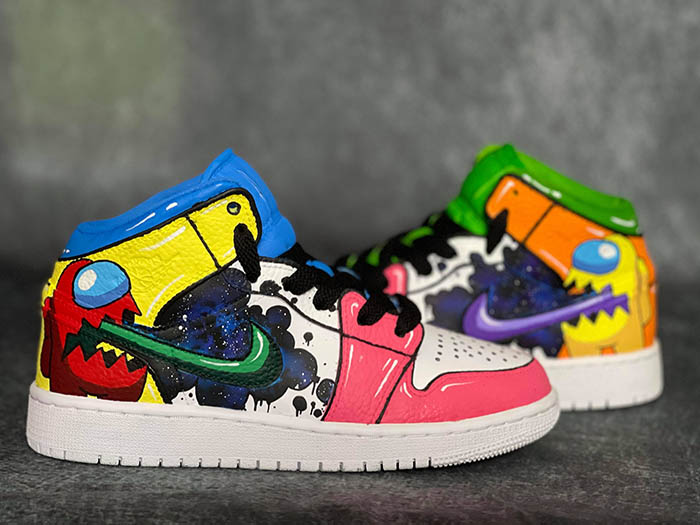When Ben Salus was looking for a new canvas for his art students’ design work, he only had to look down.
Salus, 41, of Homewood, teaches art at Jesse White Learning Academy in Hazel Crest with a social-justice-through-art mission. Recently, Salus challenged his second to seventh grade students to custom design a pair of sneakers. Salus said this project takes art out of the hands of the elite, as in those who have the most access to galleries and museums, and puts it in the hands of those who aren’t always heard.
Using worksheet templates, the Jesse White Learning Academy students designed sneakers that fit their own creative style. They did this through drawing, coloring, designing and then writing out their concepts. Four winners received shoes with their designs on Monday, July 12. Additionally, there are 10 runner-ups who won. The older kids among these 10 runners-up received paint kits and the younger kids received Model Magic kits.
Salus said the winners were chosen by him and collaborator Anthony Amos, the founder of Sneaker Fare, a sneaker customization business. Salus said he narrowed down the possible winners to 30 contestants. After that, he said they were narrowed down to 10 finalists by both Salus and Amos. The final four winners were selected by Amos, Salus said.
“There were kids who did really intricate color patterns and were designed well but were way too overly complex.” said Salus. “It’s not about who can draw the best. It’s really who has the best concept and idea and considers that you’re putting it onto a shoe. You’re not just putting it onto a flat surface. … Who had an idea of a color scheme? Who had an understanding of either narrative or shape that’s going to guide the viewer?”
This project was funded with a GoFundMe account, a grant from the Awesome Foundation. “The school approved our initial budget,” said Salus. The students made these designs during a time when some students were learning remotely, and others were learning in person at Jesse White Learning Academy. One of the four winners was a remote learner, said Salus.
The teacher said this project came to be because his students really responded to Amos’ work and the idea of custom sneaker design. Some students drew video game characters that meant something to them during the COVID-19 shutdown. Salus said there are people who may view this as a form of “low art,” but it’s meaningful to the students and for him that’s what matters.
“I think a lot of times when people are dealing with a community with any kind of struggle, they feel they have a solution they want to implement that’s their idea or their solution. When in reality, they don’t often ask the people who they are teaching what they’re interested in or what matters to them,” said Salus.
According to the National Center for Education Statistics, Jesse White Learning Academy is approximately 92% Black, 7% Hispanic and 63% qualify for the free or reduced cost lunch program.
A lot of times, art doesn’t relate to the day-to-day life of his students because it’s coming from “a very Eurocentric background,” Salus said. This sneaker project takes power away from those who usually tell the story at museums and galleries and gives it to his students, he said.
“To me, art is definitely a form of social protest. So, when I talk about art historically or movements of art historically, I try and make sure I’m not focusing on galleries and museums only. I teach them about graffiti art. I teach them about comic book art and graphic design. And when I teach them about comic book art, I make sure the videos and artists I find to study are representative of the school population. So essentially, it’s not a bunch of dead, old, white dudes.
“I engage in things like Critical Race Theory and stuff like that. But I don’t engage it with ‘I know what the answer is. I know what the point is,’” Salus said. “If I’m asking them questions in relation to the artwork, the placement of the artwork and how those things relate to race, I want them to think about it and discuss it.
“The cultural position that I’m coming from is probably different than people assume at first glance. My stepfamily that raised me is Latino. I’m bilingual. I’m Jewish. I’m autism spectrum.
“I talked to my students, and we analyzed ‘Why is Superman being accepted in America?’ He’s essentially not a citizen. He’s an undocumented immigrant. He has all these powers. They should be afraid of him theoretically, but he’s wearing red, white and blue and he’s depicted as some kind of Jesus figure. What does that say to us? What does that mean?
“I have the support of my administration, which is one of the main reasons I’m at that school. They support me and they support the arts and what I want to do.”
Salus said he “can’t remember ever being interested in anything but the arts.” When he attended the American Academy of Art to obtain his bachelor’s degree, he said it was the first time he “ever really excelled.” Since then, in addition to teaching art, he painted a mural at the Homewood Public Library and is currently working on a book collection of his artwork.


